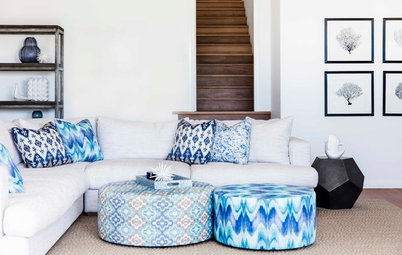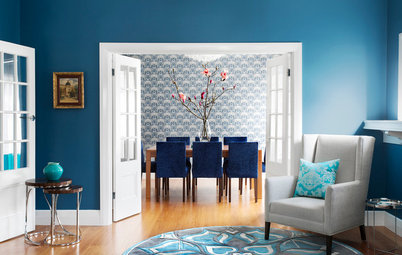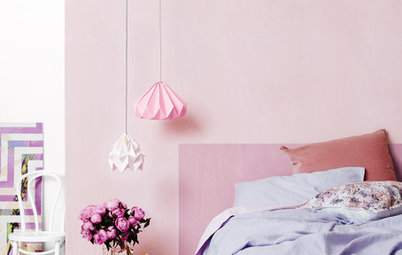Interior Design
Decorating
An Interior Designer Reveals How to Mix Colours and Make it Work
Don’t want to confine yourself to neutrals but lack the confidence to embrace colours? We have you covered
White on white, white mixed with grey, and maybe a little more white? It’s certainly an in-demand look, but some people want a bit of bold colour in their palettes. To help you mix colour with more colour and get the look you crave (without going overboard), here are some of my top tips for what hues to mix, how to combine them and how to bring the whole look together.
Tone-on-tone designs
An even more vibrant blue is still an easy colour to mix. It works beautifully in tone-on-tone designs, such as this living area by Scott Weston Architecture Design, to give the sense of dramatic colour even when most is essentially the same hue.
Try combining pure, chilly blues with green-blues or blue-indigos to get subtle variation while visually tying the hues together. Include a few hot accents for contrast – flowers are a great way to add a red or violet counterpoint.
An even more vibrant blue is still an easy colour to mix. It works beautifully in tone-on-tone designs, such as this living area by Scott Weston Architecture Design, to give the sense of dramatic colour even when most is essentially the same hue.
Try combining pure, chilly blues with green-blues or blue-indigos to get subtle variation while visually tying the hues together. Include a few hot accents for contrast – flowers are a great way to add a red or violet counterpoint.
Warm colours can also make for engaging tone-on-tone looks, although with hot hues, it’s usually safer to stick to lighter shades for walls and large areas to avoid colour overload.
Here, soft pink walls paired with vivid accents create a strong colour statement, but the punchy focal pieces, such as a patterned rug, make the walls feel less dramatic by comparison. Again, notice that the background pure-pink shade is offset by shades that are more orange- and purple-based to give variety while staying grounded.
Subtle Ways to Decorate With Pink
Here, soft pink walls paired with vivid accents create a strong colour statement, but the punchy focal pieces, such as a patterned rug, make the walls feel less dramatic by comparison. Again, notice that the background pure-pink shade is offset by shades that are more orange- and purple-based to give variety while staying grounded.
Subtle Ways to Decorate With Pink
More is more
In total contrast to the tone-on-tone look, another approach is to use a little of every colour imaginable so that no single hue feels too overpowering.
Try choosing a very colourful piece of art to inspire your palette. Then pick up fabric accents that echo a similar palette, such as the scatter cushions on the window bench seen here. This room feels exceptionally colourful, even though most of the large pieces of furniture are neutral, with the exception of the vibrant artwork and pair of pink armchairs.
In total contrast to the tone-on-tone look, another approach is to use a little of every colour imaginable so that no single hue feels too overpowering.
Try choosing a very colourful piece of art to inspire your palette. Then pick up fabric accents that echo a similar palette, such as the scatter cushions on the window bench seen here. This room feels exceptionally colourful, even though most of the large pieces of furniture are neutral, with the exception of the vibrant artwork and pair of pink armchairs.
Wallpaper
Another way to achieve a rich palette is to choose a bold wallpaper print that has a terrific colour combination.
In this room the dark blue shades in the wallpaper are picked up in the headboard and curtains, while the yellows in the wallpaper are echoed in the cushion and lamp.
Bed linen offers a great opportunity to try a risky colour, like this perfect contrasting pink. Because you can expect high-use linens to eventually wear out and need replacing, it’s not an extremely long-term or permanent commitment.
How to Get Past Your Fear of Way-Out Wallpaper Prints
Another way to achieve a rich palette is to choose a bold wallpaper print that has a terrific colour combination.
In this room the dark blue shades in the wallpaper are picked up in the headboard and curtains, while the yellows in the wallpaper are echoed in the cushion and lamp.
Bed linen offers a great opportunity to try a risky colour, like this perfect contrasting pink. Because you can expect high-use linens to eventually wear out and need replacing, it’s not an extremely long-term or permanent commitment.
How to Get Past Your Fear of Way-Out Wallpaper Prints
Patterns with solids
Notice how this room and the previous two use a mix of small-scale patterns with chunky solids? Each piece either carries many diverse hues, just one colour, or one shade mixed with a little white.
Keeping each piece to this rule of extremes isn’t necessary, but it does make it easier if you’re not confident about mixing colours. The very colourful pieces combine well because they don’t have one single hue that stands out (and might clash with another), and the solids are drawn from the art so they have something to relate back to.
Tip: When pulling colours from art to use as wall hues or solid fabrics, it’s generally safest to pick slightly greyer or paler versions to keep them from looking overly vibrant. However, some of these looks ignore that rule and, if you’re feeling bold, you certainly can too.
Notice how this room and the previous two use a mix of small-scale patterns with chunky solids? Each piece either carries many diverse hues, just one colour, or one shade mixed with a little white.
Keeping each piece to this rule of extremes isn’t necessary, but it does make it easier if you’re not confident about mixing colours. The very colourful pieces combine well because they don’t have one single hue that stands out (and might clash with another), and the solids are drawn from the art so they have something to relate back to.
Tip: When pulling colours from art to use as wall hues or solid fabrics, it’s generally safest to pick slightly greyer or paler versions to keep them from looking overly vibrant. However, some of these looks ignore that rule and, if you’re feeling bold, you certainly can too.
Breaking it up
When you mix colour with colour, the neutral elements often end up being emphasised. In this room, the mostly white artwork breaks up the blue wall, providing a bit of visual breathing room that really makes the art sing.
You can achieve a similar visual break by adding a framed photo with deep white matting (the border between the image and the frame) or arranging many frames in a grid. That the walls are a bright hue makes the room feel alive, but you can use this trick to reintroduce as much white as you need to tame the look to your liking.
Browse more Scandi-inspired blue interiors
When you mix colour with colour, the neutral elements often end up being emphasised. In this room, the mostly white artwork breaks up the blue wall, providing a bit of visual breathing room that really makes the art sing.
You can achieve a similar visual break by adding a framed photo with deep white matting (the border between the image and the frame) or arranging many frames in a grid. That the walls are a bright hue makes the room feel alive, but you can use this trick to reintroduce as much white as you need to tame the look to your liking.
Browse more Scandi-inspired blue interiors
White trim
Thick white trims (and similar elements including wall mouldings and doors) can eat up a lot of wall space. In a case like this, when you paint your walls a non-neutral colour, the amount of colourful square metreage is often surprisingly low. The result feels colourful, but in an easy and liveable way.
Notice how this room also uses the previous tricks of using a semi-neutral green on the walls and layering art with lots of white. Even with the addition of hot-red accents, the room feels balanced and approachable.
Thick white trims (and similar elements including wall mouldings and doors) can eat up a lot of wall space. In a case like this, when you paint your walls a non-neutral colour, the amount of colourful square metreage is often surprisingly low. The result feels colourful, but in an easy and liveable way.
Notice how this room also uses the previous tricks of using a semi-neutral green on the walls and layering art with lots of white. Even with the addition of hot-red accents, the room feels balanced and approachable.
Timber
Another great way to diffuse a colourful look that might start to feel overloaded is to add a little timber.
In this room, the designers featured an elegant timber desk. But the wooden chairs, exposed floors and sliding door also break up the vivid colour combination and add natural warmth to balance out powerful man-made hues.
Another great way to diffuse a colourful look that might start to feel overloaded is to add a little timber.
In this room, the designers featured an elegant timber desk. But the wooden chairs, exposed floors and sliding door also break up the vivid colour combination and add natural warmth to balance out powerful man-made hues.
Cushions
If you don’t want to invest in art and upholstery, you could inject lots of colour through piling on throw cushions, as seen in this room. You can easily mix in many colours, building the look up or down by moving pieces around until it feels just right.
Tip: You can find fabrics to use as colour-palette inspiration by borrowing a swatch from a fabric showroom or simply taking a photo of one you like. Even if you don’t end up using it, each shade can help guide your other colour choices.
If you don’t want to invest in art and upholstery, you could inject lots of colour through piling on throw cushions, as seen in this room. You can easily mix in many colours, building the look up or down by moving pieces around until it feels just right.
Tip: You can find fabrics to use as colour-palette inspiration by borrowing a swatch from a fabric showroom or simply taking a photo of one you like. Even if you don’t end up using it, each shade can help guide your other colour choices.
Small splashes
You may not have a pile of pillows in every room, but you can still add lots of playful colour.
Eclectic art, mixed chairs and fun casual lighting provide lots of colour here. Try printing interesting images from your favourite websites or cropping great photos from magazines to fill a gallery wall of frames. You can always change the images later and go back to a less colourful collage, but I bet you won’t want to.
You may not have a pile of pillows in every room, but you can still add lots of playful colour.
Eclectic art, mixed chairs and fun casual lighting provide lots of colour here. Try printing interesting images from your favourite websites or cropping great photos from magazines to fill a gallery wall of frames. You can always change the images later and go back to a less colourful collage, but I bet you won’t want to.
Texture
When working with lots of colour, don’t forget to add interesting texture, especially if the colourful pieces are mostly painted in flat shades.
A bit of texture, rich or rough, lends depth that bright pieces can lack on their own, and it keeps the look feeling sophisticated.
Don’t happen to have a rough brick wall handy? Try introducing pieces with a cement-effect finish, textured linen drapery, woven baskets or anything with a rugged appeal to balance out pristine colours and bring your dreamy palette back down to earth.
Tell us
What tricks do you use when mixing colours at home? Tell us your tips in the Comments below, like this story, save the images and join the conversation.
More
Still unsure how to draw different colours together in your interior? Find a decorator near you who can do it for you
When working with lots of colour, don’t forget to add interesting texture, especially if the colourful pieces are mostly painted in flat shades.
A bit of texture, rich or rough, lends depth that bright pieces can lack on their own, and it keeps the look feeling sophisticated.
Don’t happen to have a rough brick wall handy? Try introducing pieces with a cement-effect finish, textured linen drapery, woven baskets or anything with a rugged appeal to balance out pristine colours and bring your dreamy palette back down to earth.
Tell us
What tricks do you use when mixing colours at home? Tell us your tips in the Comments below, like this story, save the images and join the conversation.
More
Still unsure how to draw different colours together in your interior? Find a decorator near you who can do it for you



















In recent years, the trend of embracing semi-neutrals has returned. These are colours that can’t be considered true neutrals, but are still easy to combine and work with. Blues and greens, being such natural hues, tend to be the most cooperative of colours, and this is especially true when you choose mid-tone shades with a hint of grey, as seen in this kitchen by Brett Mickan Interior Design.
When combined, such hues feel lively; but when neither is overly strong on its own, the resulting pairing isn’t over-the-top.